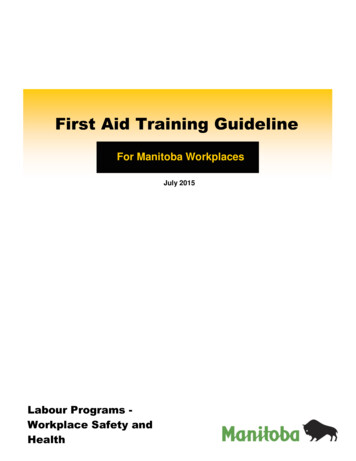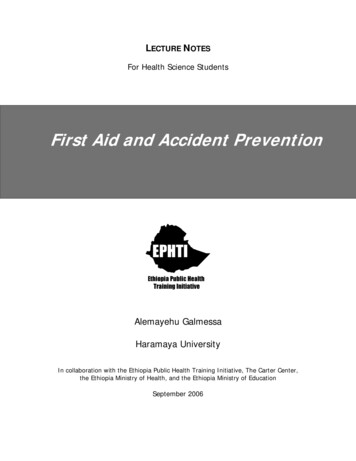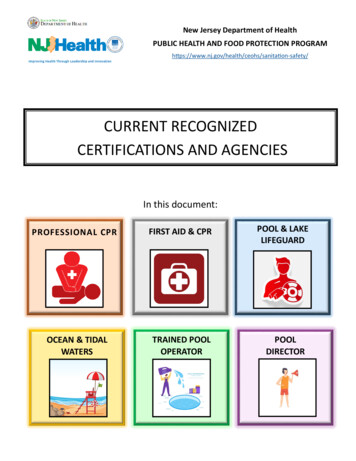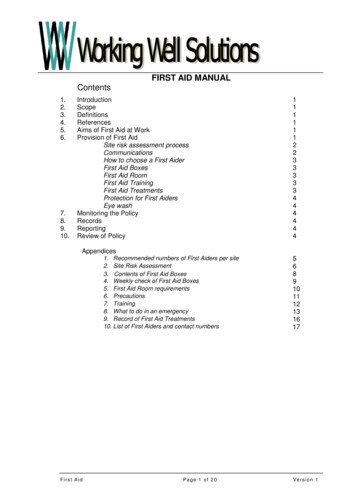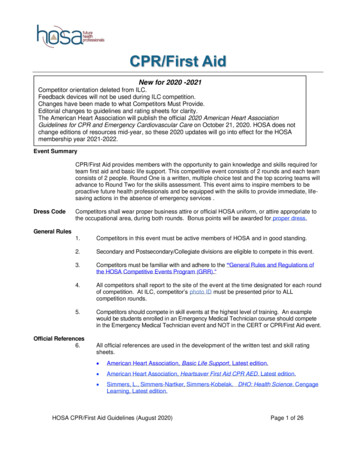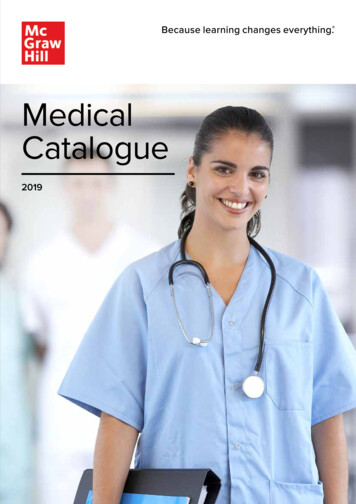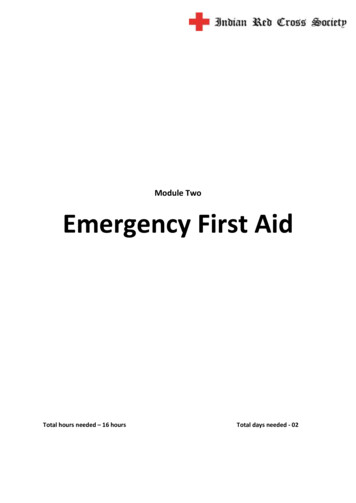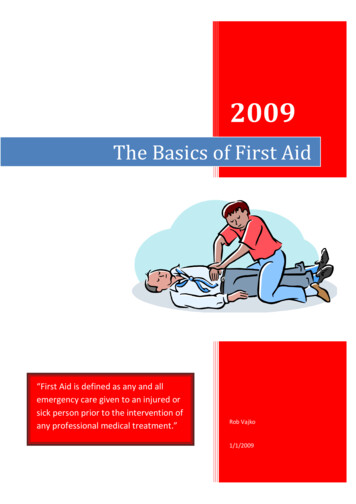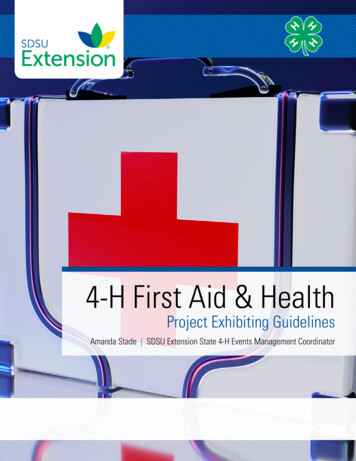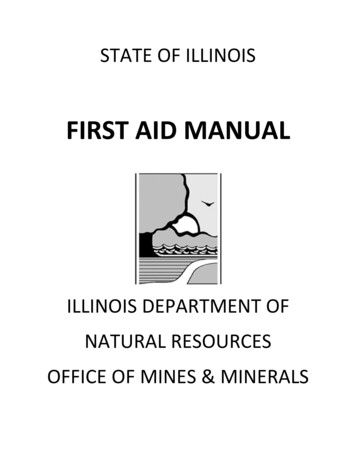
Transcription
STATE OF ILLINOISFIRST AID MANUALILLINOIS DEPARTMENT OFNATURAL RESOURCESOFFICE OF MINES & MINERALS
The contents contained herein were developed through the use of funds provided by the U.S.Department of the Interior, Bureau of Mines and by this notice the Bureau does not agree or disagreewith any of the ideas expressed or implied in this publication.Lesson 1First Aid‐Artificial Respiration,Control of Bleeding, PhysicalShock, Wounds and Burns,Dislocation & Fractures,Transportation of the Injured,Questions & AnswersFirst Aid TO THE INJUREDARTIFICIAL RESPIRATION1.Q. What is the first fundamental of first aid?A. Artificial respiration2.Q. What is artificial respiration?A. A method by which normal respiration is initiated by manual movements or mechanicalrespirators to restore breathing.3.Q. What are some of the conditions in which artificial respiration is required?A. Electric shock, gas poisoning, drowning, and suffocation from various causes.4.Q. When artificial respiration is necessary, how soon should it begin?A. It should begun at once if the patient is at a point free from danger; otherwise, as soon as thepatient has been moved to a safe place.5.Q. How long should artificial respiration be continued?A. Until natural breathing has been restored or until a physician pronounces the patient dead.2
6.Q. How should the patient be prepared for artificial respiration?A. All foreign bodies should be removed from the mouth; the tongue should be pulled forward,and only if assistance is available, he should loosen tight clothing at the neck, chest, and waist.Administrating, artificial respiration, should not be delayed until adjustments have been made inloosening the victim’s clothing.7.Q. Should treatment for physical shock be given during artificial respiration?A. Treatment for physical shock should be given throughout artificial respiration.8.Q. What care is necessary after the patient has been revived?A. He should be kept lying down, wrapped in a blanket, and given some stimulant, such asaromatic spirits of ammonia (1 teaspoon in one‐half glass of water) or hot drinks of coffee ortea.9.Q. What are the symptoms of electric shock?A. Sudden loss of consciousness, absent or very slight respiration, absent or very weak pulse,and probable burns.10. Q. When a person who has received an electric shock is still in contact with the electricconductor, what should be done first?A. He must be rescued from contact immediately.11. Q. Name some of the means by which a person may be removed from contact with an electricConductor.A. Cutting off the current at a switch; short‐circuiting or grounding the current; dragging orprying the person from contact using non conductive material to do this; dragging or prying theconductor from the patient; cutting the conductor.12. Q. What precautions should be taken by the person removing another from electric contact?A. He should always be absolutely sure he is properly insulated from the electric current bystanding on a dry surface or by using a dry belt, handkerchief, or piece of dry clothing to pull thevictim away from contact with the circuit.13. Q. How many gas poisoning be prevented?A. the chief factors in preventing poisoning by gases are good ventilation, avoidance as far aspossible of air known to contain poisonous gases, and the use of adequate protectiveequipment in atmospheres know to contain poisonous gases.3
4
14. Q. Describe the general care of a patient suffering from gas poisoning.A. Rescue the patient, and remove him to fresh air as quickly as possible. Procure medical aid; ifbreathing has stopped or is weak or intermittent, begin artificial respiration promptly &CPR/AED.15. Q. How should a drowning person be handled?A. As soon as a drowned person has been rescued artificial respiration & CPR/AED should bebegun at once and continued until he is revived or is known to be dead.16. Q. How should a suffocated or asphyxiated person be handled?A. He should be removed immediately to fresh air. If some object is blocking his windpipe, itshould be removed and artificial respiration & CPR begun.Control of Bleeding17. Q. What is the second fundamental of first aid?A. The second fundamental in first aid is the control of bleeding.18. Q. What is hemorrhage or bleeding?A. A flow of blood from an artery, vein, or capillary.19. Q. What are the symptoms of bleeding from an artery?A. The blood spurts intermittently and is bright red.20. Q. What are the symptoms of bleeding from a vein?A. Bleeding is a steady flow, and the blood is darker red.21. Q. What are the symptoms of capillary bleeding?A. The blood just oozes from the wound.22. Q. If blood is spurting from a wound or flowing in a steady stream, what should be done andwhy?A. It should be checked as soon as possible or the patient may lose enough blood to cause shockor endanger life. Arterial bleeding should be checked by direct pressure, either by hand or bycompress bandage, digital pressure, or by tourniquet.23. Q. What amount of blood lost by an adult is likely to prove fatal?A. The loss of 2 to 3 pints of blood may prove fatal.5
PREASURE POINTS6
BLEEDING CHARACTERISTICSArteries‐Spurting blood‐Pulsating flow‐Bright red colorVeins‐Steady flow‐Dark red colorCapillaries‐slow even flow7
24. Q. How may the flow of blood be stopped from a wound with venous bleeding?A. Bleeding from a vein usually can be checked by applying a sterile bandage compress directlyover the wound. If this fails, a constriction should be applied on the side of the wound awayfrom the heart.25. Q. How would you stop the flow where capillaries are cut?A. By sterile bandage compress applied directly over the wound.26. Q. What is meant by the pressure point, and how many are there in the human body?A. A point where an artery comes close enough to the surface of the skin to be reached; itsproximity to a body structure allows pressure on the artery against the bone. There are 22pressure points on the human body.27. Q. Describe digital pressure.A. Digital pressure is that exerted by the finger or thumb against an artery at a pressure point.28. Q. What is a tourniquet?A. An appliance used to check severe bleeding from an artery at a pressure point. A tourniquetcan be used only to control arterial bleeding of the extremities and seldom ever completelystops bleeding.29. Q. What types of tourniquets are used in first aid?A. The standard type (usually a piece of web belting about 36 inches long, with a buckle or snapdevice to hold it tight when applied) and improvised tourniquets of suitable material to hold ahard object against the pressure points.30. Q. What precautions should be taken with a hard object used with a tourniquet?A. It should be wrapped well or padded with cloth in order not to bruise the skin and the walls ofthe artery.31. Q. How long should a tourniquet be allowed to remain tight?A. The tourniquet should be loosened for a few seconds or until normal color returns to thepart below the tourniquet; if bleeding persists, it should be tighten again for another interval of10 minutes.8
32. Q. What is the duty of the first aid man when he turns a patient with a tourniquet in place overto someone else?A. When a patient with a tourniquet or venous‐control constriction in place is turned over tosomeone else, the first‐ aid man must inform whoever receives the patient that a tourniquet orconstriction has been applied and, if tight, how long it has been tight.Physical Shock33. Q. What is the third fundamental of first aid?A. Treatment of physical shock.34. Q. What is physical shock?A. A statement of collapse or prostration in which the normal action of the heart, therespiration, and circulation are impeded.35. Q. What are the causes of physical shock?A. Severe or extensive injuries, severe pain, loss of blood, surgical operations, severe burns,accidents due to electricity or gas, certain illnesses, poisons taken internally, exposure toextremes of heat or cold, seeing own injuries or injuries of others, fright, anger, and joy,mishandling of injured persons is one of the more common causes of physical shock.36. Q. Does physical shock occur after every injury?A. Physical shock occurs to some degree after every injury. It may be so slight as not to benoticed.37. Q. How soon after the symptoms of physical shock are noticed should it be treated?A. Physical shock should be treated immediately after the first evidence of its presence.38. Q. What are the symptoms of physical shock?A. Face if pale with an anxious or dull expression. The eye lids, if open, droop; the pupils arelarge, and the eyes are dull. The patient may be partly or totally unconscious. The skin is coldand covered with a clammy sweat. The patient feels cold and may have a chill. The pulse is weakand rapid if it can be felt. The breathing is shallow and may be irregular. The patient is confusedand takes little interest in things about him. He may answer questions slowly or apparently failto understand. He may be nauseated and vomit.9
10
39. Q. What is the treatment of physical shock?A. Place the patient in a comfortable position lying down, with his head on a level with his body;if there is a moderate slope to the ground where the patient is lying, place the head toward thedown grade. If the patient is on a stretcher or body splint, elevate the feet end of the stretcheror body splint at least 6 inches. Use a confident calming voice. Remove all foreign bodies fromhis mouth, and cleanse the mouth of mucus or phlegm. See that the tongue is forward and notback over the wind pipe. Loosen tight clothing and neck. If the patient is nauseated and vomitsturn his head to one side so that the vomited matter will flow from the mouth and not chokehim. Allow the patient to have plenty of fresh air. Wrap him in blankets or other suitablecovering. Care should be taken that the material placed around him does not contaminate openwounds. Maintain heat under covering by applying heated objects .Give stimulants, byinhalations if the patient is unconscious or by mouth if he is conscious. Rub uninjuredextremities toward the heart. Oxygen should be administered if available.40. Q. How should stimulants be given to an unconscious person in physical shock?A. Give nothing by mouth, as the patient may not shallow it, and the substance may pass into hiswindpipe and choke him. Aromatic spirits of ammonia should be administered by pouring someon a piece of gauze or cloth holding it under the nose for 30 to 40 seconds. The aromatic spiritsshould be tested before the patient is allowed to inhale it.41. Q. Under what conditions where physical shock is present should the head be raised?A. Fracture of the skull, severe bleeding from the head, sunstroke, and apoplexy.42. Q. Under what condition where physical shock is present should the patient not be wrapped inblankets?A. In sunstroke.43. Q. Under what conditions where physical shock is present should no stimulant be given?A. In case of severe bleeding, fracture of the skull, or sunstroke, stimulant should not be given.44. Q. What is the fourth fundamental of first aid?A. The care of open wounds and burns.45. Q. What is an open wound?A. Any break in the skin. It may range from a pin puncture or scratch to an extensive cut, tear, ormash.11
46. Q. Describe the general care of open wounds.A. Check hemorrhage, and prevent any germs from entering wound by covering immediatelywith a sterile dressing.47. Q. Tell how the clothing should be removed to expose wounds.A. Rip or cut the clothing so that the injury may be seen.48. Q. What should be done where loose foreign particles are in or around wound?A. Loose foreign particles in and around a wound may be wiped away with sterile gauze. Alwayswipe away with sterile gauze. Always wipe away from the wound and not toward it.49. Q. what should be done where foreign objects are embedded in an open wound?A. Do not attempt to remove a foreign object embedded in a wound. Leave that to the doctor,as it may aid him in determining the extent of injury and involvement of deeper parts.50. Q. What only may touch an open wound?A. A sterile bandage compress or sterile gauze placed over the wound and tied in place. Do nottouch an open wound with your hand, clothing, or anything that is not sterile.51. Q. How large should sterile dressings be for an open wound?A. Care should be taken to make all sterile dressings wide enough to cover the woundcompletely, as well as an area beyond each side of the wound.52. Q. How should bandages be applied in dressing for open wounds?A. The bandages should be applied firmly but never too tightly. In bandaging the arms and legs,leave the tips of the fingers and toes uncovered wherever possible so that they may be seen, topermit easy examination and determine whether or not dressing are too tight.53. Q. Describe the general treatment for burns and scalds.A. Expose the burned surface, and apply a dressing to exclude air, relieve pain, and preventinfection.12
GENERAL CARE FOR BURNS AND SCALDS(EXCLUDING CHEMICAL BURNS)FIRST AID OBJECTIVES: EXCLUDE AIR, RELIEVE PAIN,MINIMIZE SHOCK, AND PREVENT INFECTION1. Remove clothing and jewelry from burn area ( unless it is adhered to the skin)2. Cover burn with cool, moist dressing:Use 4 to 6 layers of loosely –applied gauze or bandage3. Cover entire area with a loose dressing4. Treat for shockBURN CLASSIFICATIONSClassFirst DegreeBurns:SecondDegreeBurns:Third DegreeBurns:SymptomsReddened outer skin swellingReddened skin, Blisters (open orclosed) Damaged under skin.Skin is destroyed, under skintissue, exposed and damaged,Area may be charred13
Types Of Open WoundsCauseCharacteristics SpecialConcernsAbrasionsRubbing or InvolvesDangerofScrapingsurface areas Infectionof skin, littlebleedingIncisionsSharpClean edges, Severeinstruments, Caninvolve bleedingor objectscut arteries orveinsLacerations Blunt, heavy Torn, bruised Severeinstruments tissue,Can bleeding,or objectsinvolvecut Foreignarteriesor materials inwoundveins(danger ofinfection)PuncturesPointedNarrow, deep Embeddedinstruments wounds, Can objects,or objectsinvolve cutDangerofarteriesor infectionveins14
54. Q. How should all clothing be removed from a burned area?A. By cutting or ripping; any cloth that adheres to the skin should be cut around and left in place.55. Q. Are burns and scalds subject to infection?A. Yes; just as are open wounds.56. Q. Should Blisters be opened?A. Blisters should not be intentionally open or broken.57. Q. What precautions are necessary in dressing a burn or scalded surfaces may come in contactwith each other?A. Adjacent burned surfaces should never be permitted to come in contact with each other. Aburn dressing should be placed between such surfaces,58. Q. Should bandages be applied in dressing burns or scalds?A. They should always be applied loosely, but snugly enough to hold in place.DISLOCATIONS AND FRACTURES59. Q. What is the fifth fundamental of first aid?A. The care of locations and fractures.60. Q. What is a dislocation?A. A dislocation is a slipping out of normal position of one or more bones forming a joint.61. Q. What other injuries usually accompany a dislocation?A. The ligaments holding the bones in proper position are stretched and sometimes torn.62. Q. What are the general symptoms of dislocations?A. Rigidity and loss of function. The parts forming the joint are held stiff and cannot be moved.There is deformity; that is, the parts assume an unnatural shape compared with the normal jointon the opposite side of the body. In dislocations of the extremities, they may be either shorter15
or longer than normal. Pain usually is severe in the region of the joint. Swelling is present aboutthe joint.63. Q. What is the general treatment for dislocation?A. Appling dressings, and in some instances splints, so that the parts are immobilized in the lineof deformity in which they are found.64. Q. What dislocations may a first‐aid attempt to reduce?A. In first aid, dislocations of the lower jaw, fingers, and toes may be reduced.65. Q. What are the general symptoms of fractures?A. Pain in the region of the fracture, loss of function (if the long bones are involved) deformity orirregularity of the part, and swelling, moderate or severe; in fractures of the extremities, thelimbs usually are shortened.66. Q. What is the general treatment of fractures?A. Place the part in a position as nearly normal as possible; and while support is maintained,prepare and apply a splint to immobilize the part so that movement is impossible. Always splintthe way you found it.67. Q. How does the treatment of a simple fracture differ from that of a compound fracture?A. A simple fracture requires only immobilization by proper dressing, whereas a compoundfracture requires that a tourniquet be applied, tightly if there is evidence of arterial bleeding,otherwise loosely. The splints are applied in a compound fracture the padding must be soarranged that the tourniquet can be tightened or loosened and that no pressure is made overthe wound or on protruding ends of bones. Shock may be present in either simple or compoundfracture.TRANSPORTATION OF THE INJURED68. Q. What is the sixth fundamental of first aid?A. Transportation of the injured.69. Q. What precautions should be followed before an injured person is moved?A. Never moved an injured person until a thorough examination has been made a d his injuriesprotected by proper dressings.16
17
70. Q. In what position should a seriously injured person be transported?A. A seriously injured person should be moved only in a lying position. If means are notimmediately at hand for transportation of an injured patient, continue your care of the patientto conserve his strength until adequate means of transportation are available. Always use a neckbrace if it is unknown how the patient was injured and suspect there could be a neck injury.71. Q. What is the responsibility of a first‐aid man in transporting an injured person?A. To see that the patient is transported in such a manner that further injury is prevented, thatthe severity of the original injuries is not increased, and that the patient is subjected to nounnecessary pain or discomfort.72. Q. What precautions always should be taken before a patient is loaded on a stretcher?A. A stretcher always should be tested by a weight equal to or greater than that of the patientbefore the injured person is placed on it.73. Q. In carrying patient on a stretcher, why should the rear man be out of step with the otherstretcher bearers?A. The rear man breaks step with the other stretcher bearers to prevent swinging of thestretcher. There may be exceptions to this rule.74. Q. On which side is it preferable to lift an injured patient when loading or unloading a stretcher?A. It is preferable to lift the patient on the injured or least injured side before placing him on orunloading him from a stretcher. There may be exceptions to this rule.QUESTIONS AND ANSWERS FOR FIRST AID1.Q. What is First Aid?A. First aid is emergency care of a person who is injured or ill, to prevent death or further injury,to relieve pain, and to counteract shock until medical aid can be obtained.The imperative need for first aid in many injuries where medical aid is not immediately availablemakes it the duty of everyone to be able to give proper assistance until a doctor arrives or theinjured person can be taken to the doctor.Even today, as in its inception, the first aid instructions have their limitations. First aid is nevertaught to replace the physician or surgeon but only to protect the patient until medical orsurgical aid can be obtained. One of the first things taught first aid men is to send for medicalaid in all cases of serious injury, and even in minor injuries to be sure that the patient sees aphysician as soon as possible.18
First aid rendered correctly, in many instances can restore natural breathing, usually check lossof blood, prevent or moderate shock, protect wounds and burns from infection, immobilizefractures and dislocations, lessen pain and conserve the patient’s strength; and when medicalaid can be obtained, his change of recovery is greatly enhanced.2.Q. What are the five principal objects of first aid?A. 1. Prevention of further injury2. Checking conditions known to be endangering life.3. Protecting injuries from infections and complications.4. Making the patient as comfortable as possible to conserve his strength.5. Transporting the patient to medical assistance, where required, in such a manner as not tocomplicate the injury or subject him to any more discomfort than is absolutely necessary.3.Q. What is the importance of first aid to the employee?A. He is trained to care properly for injuries to himself and to others while he is at work, athome, and elsewhere.He is made safety‐minded and less liable to be injured, because the training impresses the factorof personal safety through acquaintance with the dire results of injuries.He is taught that even the most trivial injuries are potential sources of danger and thereforetakes fewer chances of permitting wounds to become infected.He is stimulated to have due regard for fellow employees, both as to their safety and the propercare of injuries they may receive.4.Q. What is the importance of first aid to the employer?A. Those trained in first aid become safer integral parts of the working force, thus lowering theaccident experience rate.Better care for injured employees at the critical time is afforded in proportion to the numbertrained and their placement among the working force.Lost time caused by accidental injuries is reduced and efficiency increased.Compensation and medical costs are smaller.Further, experience of the bureau of mines has shown that, with 100 percent training of minepersonnel in first aid, intermingling of the men, the bosses, and the plant or mine officials inclasses where everyone is on a common footing and has a common interest in a humaneendeavor creates better feeling and understanding between the men and their employers. Itpropagates a spirit of mutual protection and regard for the wellbeing of all among thesupervisory and working forces.19
5.Q. What should a first aid man do in case of serious injury?A. Send for medical aid in al serious injuries. Have all supposed minor injuries checked by aphysician to be sure they have been care for properly.Be calmTake command, and give orders.Locate the injury.Know what to do, and do it.Keep onlookers away from the patient.If artificial respiration is indicated, start CPR/AED without delay.Use a knife or scissors to remove clothing.Look for bleeding, and check it (1) by pressing the fingers or thumb on the skin over the bloodvessel at the location of the pressure point (2) by a tourniquet, or (3) by a bandage compressand bandage applied with pressure over the wound.Treat for physical shock.Keep the patient lying down.Use a calm, assuring voice.Cover all wounds completely with a sterile bandage compress, or sterile gauze in case of largewounds, and a triangular or cravat bandage, except wounds of the eye, nose, chin, fingers, ortoes, where a sterile bandage compress only is used.Do not allow the fingers or instruments to touch a wound.Remove any loose foreignobjects from a wound with a piece of sterile gauze, but do not attempt removal if embedded inthe wound.Look for fractures; never move a patient, unless absolutely necessary, until splints have beenapplied.Leave reduction of dislocations or fracture to a surgeon, except dislocations of jaw, fingers, ortoes.Place a sterile bandage compress and a bandage over a compound fracture without unduepressure before applying splints.Exclude air from burned surfaces as quickly as possible by using picric‐acid gauze or othersuitable dressing.20
Remember that only part of your work completed when the patient is ready for the stretcher.Unnecessary or rough handling may undo all your work. Place the patient on the stretchercarefully, avoiding jerky movements, and carry him to safety. Always test a stretcher beforeplacing a patient on it.6.Q. What are the principles of artificial respiration?A. Where breathing has stopped or is very irregular and feeble, artificial respiration is usuallyrequired. The most frequent conditions under which artificial respiration is required are electricshock, gas poisoning, drowning, and suffocation from various causes (any situation wherebreathing has stopped).In many conditions where breathing has ceased, or apparently ceased, the heart actioncontinues for a limited time. If fresh air is brought into the lungs, so that blood can obtain theneeded oxygen from the air, life can be sustained. This can be accomplished in many instancesby artificial respiration.Certain general principals must always be kept in mind in applying any method of artificialrespiration.Time is of prime importance; seconds count. Do not take time to move the victim to a moresatisfactory place unless the place is unsafe for victim or rescuer; begin at once. Do not delayresuscitation to loosen the victim’s clothes, warm him, apply stimulants, etc. These aresecondary to the main purpose of getting air into the victim’s lungs.If at all possible, incline his body slightly to permit better drainage of fluid from the respiratorypassage.As soon as artificial respiration has been started and while it is being continued, an assistantshould remove from the victim’s mouth all foreign bodies, such as false teeth, tobacco, gum,and any loose material; see that the tongue is forward and not over the windpipe; and loosenany tight clothing about the victim’s neck, chest, or waist.Keep the victim warm, by covering him with blankets, clothing, and other material; if possible,has underside should also be covered. Place hot water bottles, hot bricks, or other heatedobjects, well‐wrapped in cloth or paper and tested to prevent burning the victim, about him.Continue artificial respiration rhythmically and uninterruptedly until spontaneous breathingstarts or a doctor pronounces the patient dead.If the victim begins to breathe of his own accord, adjust your timing to his. Do not fight hisattempt to breathe.21
A brief return of natural respiration is not a signal for stopping the resuscitation treatment. Noinfrequently a patient, after a temporary recovery of respiration, stops breathing again. He mustbe watched; if natural breathing stops, resume artificial respiration at once.Always treat the victim for shock during resuscitation and continue such treatment afterbreathing has started. Do not give any liquids whatever by mouth until a patient is fullyconscious.If it is necessary (due to extreme weather or other conditions) to move a patient before he isbreathing normally, continue artificial respiration while he is being moved.7.Q. What are the results from electric shock? How would you remove an individual from acharged electric wire?A. Electricity causes shock by paralyzing the nerve centers that control breathing or by stoppingthe regular beat of the heart. Accidents from electricity are common in and around mines. Anyelectric current is likely to be dangerous.The symptoms of electric shock are sudden loss of consciousness, absence of respiration (whichif present, is light and cannot be detected) weak pulse, and probable burns. When necessary,rescue the person as quickly as possible, being careful not to get in contact with the live wire orother conductor. If the switch is near, turn off the current, but lose no time in looking for one.Every second of delay in removing a person from contact with an electric current lessens thechance of resuscitating him. Act quickly, but always in such a way that you are protected fromcontact. Stand on a dry board, thick, dry paper, or cloth; wrap one hand with a dry coat, cap, orother non‐conducting material; and with the other hand behind your back drag the person fromcontact. If both hands must be used, see that they are insulated.Another way is take a belt, handkerchief, or coat, if it is dry, or a piece rope and loop it over thevictim’s foot or head if he is lying on the wire, and thus pull him off. If an axe is near at hand, useit to cut the wire, but first make sure that the handle is dry, or dry rope may also be used to pullthe wire from the patient. In all cases, remove the wire promptly; and, if he is not breathing,start artificial respiration at once.22
First Aid‐Artificial Respiration, Control of Bleeding, Physical Shock, Wounds and Burns, Dislocation & Fractures, Transportation of the Injured, Questions & Answers First Aid TO THE INJURED ARTIFICIAL RESPIRATION 1. Q. What is the first fundamental of
